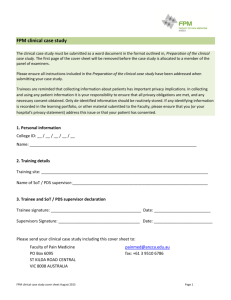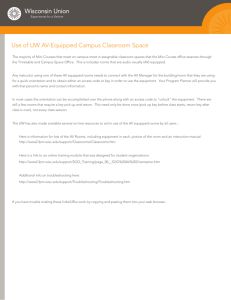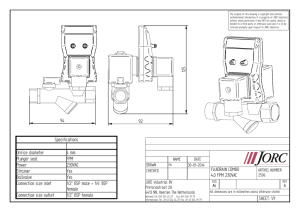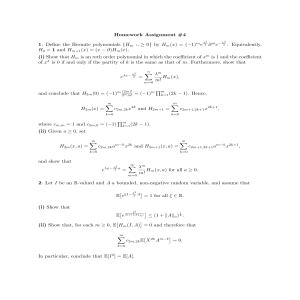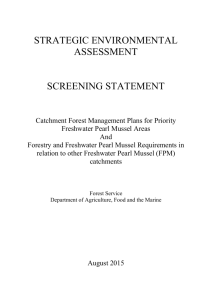ECONOMIC PRODUCTIVITY QUANTIFICATION AND SIMULATION MODELS FOR THE AIR TRANSPORT INDUSTRY
advertisement
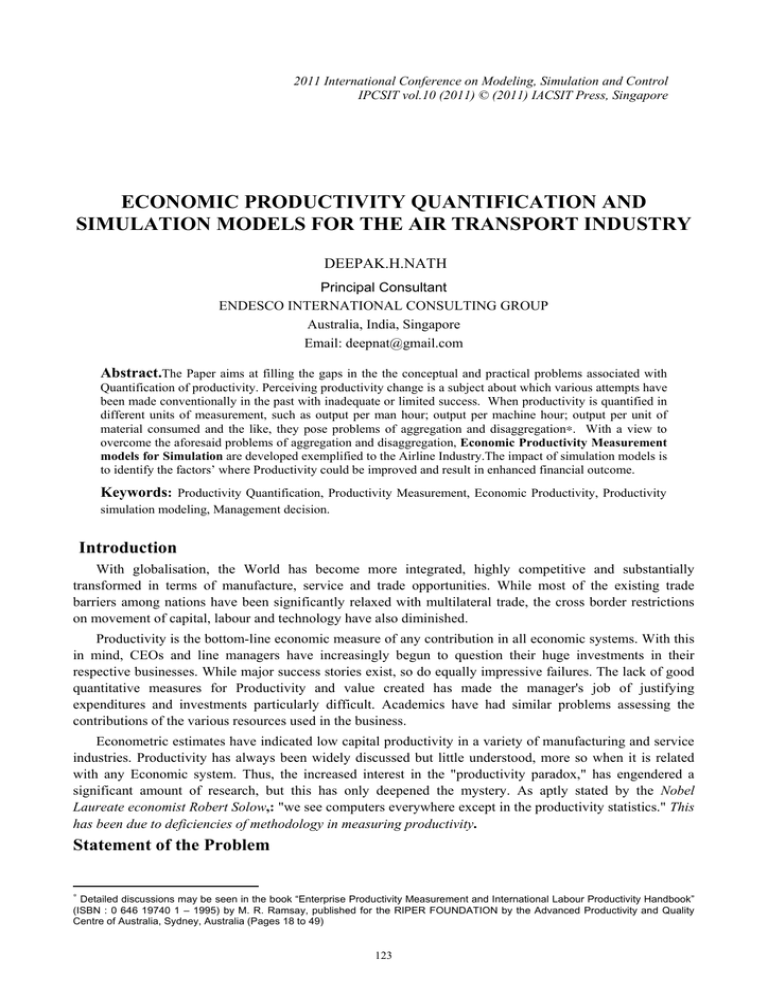
2011 International Conference on Modeling, Simulation and Control IPCSIT vol.10 (2011) © (2011) IACSIT Press, Singapore ECONOMIC PRODUCTIVITY QUANTIFICATION AND SIMULATION MODELS FOR THE AIR TRANSPORT INDUSTRY DEEPAK.H.NATH Principal Consultant ENDESCO INTERNATIONAL CONSULTING GROUP Australia, India, Singapore Email: deepnat@gmail.com Abstract.The Paper aims at filling the gaps in the the conceptual and practical problems associated with Quantification of productivity. Perceiving productivity change is a subject about which various attempts have been made conventionally in the past with inadequate or limited success. When productivity is quantified in different units of measurement, such as output per man hour; output per machine hour; output per unit of material consumed and the like, they pose problems of aggregation and disaggregation∗. With a view to overcome the aforesaid problems of aggregation and disaggregation, Economic Productivity Measurement models for Simulation are developed exemplified to the Airline Industry.The impact of simulation models is to identify the factors’ where Productivity could be improved and result in enhanced financial outcome. Keywords: Productivity Quantification, Productivity Measurement, Economic Productivity, Productivity simulation modeling, Management decision. Introduction With globalisation, the World has become more integrated, highly competitive and substantially transformed in terms of manufacture, service and trade opportunities. While most of the existing trade barriers among nations have been significantly relaxed with multilateral trade, the cross border restrictions on movement of capital, labour and technology have also diminished. Productivity is the bottom-line economic measure of any contribution in all economic systems. With this in mind, CEOs and line managers have increasingly begun to question their huge investments in their respective businesses. While major success stories exist, so do equally impressive failures. The lack of good quantitative measures for Productivity and value created has made the manager's job of justifying expenditures and investments particularly difficult. Academics have had similar problems assessing the contributions of the various resources used in the business. Econometric estimates have indicated low capital productivity in a variety of manufacturing and service industries. Productivity has always been widely discussed but little understood, more so when it is related with any Economic system. Thus, the increased interest in the "productivity paradox," has engendered a significant amount of research, but this has only deepened the mystery. As aptly stated by the Nobel Laureate economist Robert Solow,: "we see computers everywhere except in the productivity statistics." This has been due to deficiencies of methodology in measuring productivity. Statement of the Problem ∗ Detailed discussions may be seen in the book “Enterprise Productivity Measurement and International Labour Productivity Handbook” (ISBN : 0 646 19740 1 – 1995) by M. R. Ramsay, published for the RIPER FOUNDATION by the Advanced Productivity and Quality Centre of Australia, Sydney, Australia (Pages 18 to 49) 123 The concept of Productivity Measurement in Business, Industry and Service Systems in the 20th Century has largely been carried out using Physical Units of Measurement such as Output per man hour/day/year; Output per unit of Material consumed and the like, exemplified as under:Service – Example: Transportation- Airlines • Number of ton-kilometers moved per day with standard work force strength. • Number of ton-kilometers moved per 1000 litres of fuel. • Number of passenger kilometers transported per man-day. • Number of revenue hours flown per revenue earning flight. Not frequently however, the output is expressed in monetary value. In today’s world, because of globalisation and higher competition, the measurement of productivity is considered as vital both for organisations and for the State. Productivity is often used to trace technological change although the link between technological change and productivity change is not straightforward. Technology can be viewed as the currently known method of transforming inputs into outputs. It can be embodied in a product (e.g. advances in design) or disembodied (e.g. new organisational techniques). Problem of measuring inputs may become highly complex when the inputs are of a heterogonous nature, as it often happens. Many modern approaches have some drawbacks and limitations. The Paper aims at filling the above mentioned gaps in the process of Measuring Productivity by developing Economic Productivity Measurement models for Simulation Exemplified to the Airline Industry, which are based on the principles of the Ramsay Productivity Models System (RAPMODS System) [1]. Inadequacies in Productivity Measurement Methodology There are many inadequacies in the measurement of productivity, among them being:1. Cost per person hour of the work force comprising different skills not being considered in work force physical resource productivity measurement. 2. Lack of available methodology to establish a link and study the sensitivities between factors’ of productivity and Total/Aggregate productivity when measured in conventional physical units. 3. Inability to perceive the quantitative links among factors’ of productivity in physical units of measurement, profitability and Return on Investment. 4. Lack of proper understanding in perceiving the reasons and links between changes in input factor proportions and factors’ of productivity (example: In interpreting inter-period changes in the proportion of man power cost to total expenditure; In interpreting inter-period changes in the proportion of materials consumed to total expenditure and the like). 5. Lack of simulation capabilities for scenario construction in Management Decision Making. Operational definitions of the concept a. Factor Productivity Measure (FPM) which gives the System Output in monetary value per unit monetary value of each factor Input (e.g. Rupees of System Output per Rupee each of the factor Input for providing services covering any time period). b. Total Productivity Measure (TPM), which gives the System Output in monetary value per unit monetary value of Total System Input during a specific period (e.g. System Output in dollars per Dollar of Total System Input (TSI) for providing services covering any time period. Objectives and Scope 1. To develop Economic Productivity Measurement Simulation models exemplified to Airlines industry and to carryout Simulation studies for Scenario Construction, while dealing with “what if” situations in the process of decision making in Airlines Management. 2. To conduct Economic Productivity Simulation for developing productivity targeted financial budgets, Monitoring and Control, with a preventive approach for achieving Corporate Goals. 124 Developing Algebraic Models of Economic Productivity with simulation capabilities both Factors’ and Aggregate for benchmarking and to develop productivity targeted budgeting, monitoring and control with a view to enhance the quality of management and improve financial results of airlines including competitive capability. Source of Data Data is collected from the published Annual reports (2002-2006) of the Singapore Airlines incorporating Profit and Loss accounts, Balance Sheets and available details of operations. Economic Productivity Simulation Models The following is based on the models of Factor Productivity Measures (FPMs) and Total/Overall productivity Measures for the Airline Industry have been developed (Factors’ of the Singapore Airlines (SA) have been used for exemplification purpose):1. Factor Productivity Measure (Staff Costs) – FPM (SC) ⎡ RAPMODS System Output (RSO) ($) ⎤ ⎡ $ 13,225.4 FPM(SC) = ⎢ ⎥ = ⎢ $ 2,481.1 Staff Costs ($) ⎣ ⎦ ⎣ ⎤ ⎥ = 5.3305 ⎦ FPM (SC) 5.3305 means, for every dollar spent on Employee Costs, an RSO [3] of $5.3305 has been achieved by the Singapore Airlines. If this figure is improved, Economic Productivity of Employee Costs will have improved. On the similar lines Economic Productivity Measurements may be computed to all other input resources (Table 1). Table 1: Factor Productivity Measures (FPMs) Factor Productivity Measures (FPMs) Year 2002 2003 2004 FPM (Fuel costs) – FC 5.2349 4.6183 4.9593 FPM (Staff costs) – SC 9.6079 9.5101 8.2761 FPM (Depreciation) – D 0.0000 0.0000 0.0000 FPM (Landing, parking and over flying charges) - LPFC 5174.3889 241.1372 348.8357 FPM (Handling charges) – HC 5.2803 5.5609 5.3931 FPM (Other operating expenses) – OOE 16.6082 13.2781 15.9938 FPM (Commission and incentives) - CI 15.9212 15.3500 16.5465 FPM (Rentals on leased aircraft) – RLA 17.5205 17.9984 18.9327 FPM (Material costs) - MC 16.9900 19.8981 19.8283 FPM (Aircraft maintenance and overhaul costs) - AMOC 29.6527 28.9230 27.6462 FPM (In-flight meals) - IFM 29.6527 33.1593 39.4324 FPM (Advertising and sales costs) - ASC 42.7635 47.5638 49.3054 FPM (Company accommodation and utilities) - CAU 48.7129 49.7071 51.1382 FPM (Other passenger costs) - OPC 93.3257 57.9268 73.1640 FPM (Crew expenses) - CE 66.1969 76.5798 0.0000 FPM (Insurance expenses) - IE 77.5512 79.3336 92.4943 FPM (Finance charges) - FIC 92.7679 104.8423 108.4062 FPM (Amortisation of intangible assets) AIA 42.3167 28.8666 23.6442 FPM (Provision for impairment of fixed assets) - PIFA 211.6795 189.5594 150.0369 2. Total Productivity Measure (TPM) TPM ⎡ Output = ⎢ ⎢⎣ Input ⎤ ⎥ ⎥⎦ 125 2005 4.8789 9.7615 0.0000 2006 5.3305 10.7725 1093.0083 Benchmark FPMs 5.3305 10.7725 1093.0083 275.6472 4.3810 19.7319 26.4998 18.7325 20.6868 241.7806 3.1190 41.4200 29.9488 20.2564 22.2913 5174.3889 5.5609 41.4200 29.9488 20.2564 22.2913 35.2170 40.2515 39.1284 41.9588 53.4360 39.1284 41.9588 53.4360 45.7630 90.6818 0.0000 0.0000 109.0360 54.3361 115.4049 83.6521 107.9624 112.9411 54.3361 115.4049 83.6521 107.9624 112.9411 26.2755 29.4946 42.3167 152.2284 137.3354 211.6795 48.0558 ⎡ ⎢ ⎢ ⎢ ⎢ ⎢ ⎢ ⎢ ⎢ Output =⎢ ⎢ Output + Output + Output + Output + Output + Output + Output + Output ⎢ FPM FPM (ASC) FPM (FC) FPM (SC) FPM (D) FPM (HC) FPM (RLA) FPM (LPFC) (IFM) ⎢ ⎢ Output Output Output Output Output Output Output Output + + + + + + + ⎢+ FPM FPM FPM FPM FPM FPM FPM FPM ⎢ (MC) (AMOV) (CI) (IE) (OPC) (CE) (OOE) (CAU) ⎢ ⎢ + Output + Output + Output ⎢ FPM (FIC) FPM (AIA) FPM (PIFA) ⎣ ⎤ ⎥ ⎥ ⎥ ⎥ ⎥ ⎥ ⎥ ⎥ ⎥ ⎥ ⎥ ⎥ ⎥ ⎥ ⎥ ⎥ ⎥ ⎥ ⎦ Dividing the numerator and denominator by Output, we have ⎡ ⎤ ⎢ ⎥ ⎢ ⎥ ⎢ ⎥ ⎢ ⎥ ⎢ ⎥ ⎢ ⎥ ⎢ ⎥ ⎢ ⎥ 1 ⎥ =⎢ ⎢ ⎥ 1 1 1 1 1 1 1 1 + + + + + + + ⎢ ⎥ FPM FPM FPM FPM FPM FPM FPM FPM ⎢ ⎥ (IFM) (ASC) (FC) (SC) (D) (HC) (RLA) (LPFC) ⎢ ⎥ 1 1 1 1 1 1 1 1 ⎢+ ⎥ + + + + + + + ⎢ FPM ⎥ FPM FPM FPM FPM FPM FPM FPM (CAU) ⎥ (OOE) (CE) (OPC) (IE) (CI) (AMOV) (MC) ⎢ ⎢ ⎥ 1 1 1 + + ⎢+ ⎥ FPM FPM FPM (PIFA) (AIA) (FIC) ⎣⎢ ⎦⎥ 3. Per unit profit (K) = ⎛ ⎞ 1 1 1 1 1 1 1 1 ⎜ ⎟ + + + + + + + ⎜ FPM ⎟ FPM FPM FPM FPM FPM FPM FPM (IFM) (ASC) (FC) (SC) (D) (HC) (RLA) (LPFC) ⎜ ⎟ ⎜ ⎟ 1 1 1 1 1 1 1 1 + + + + + + + 1− ⎜+ ⎟ ⎜ FPM (MC) FPM (AMOV) FPM (CI) FPM (IE) FPM (OPC) FPM (CE) FPM (OOE) FPM (CAU) ⎟ ⎜ ⎟ 1 1 1 ⎜+ ⎟ + + ⎜ FPM ⎟ FPM FPM (FIC) (AIA) (PIFA) ⎝ ⎠ Substituting the respective measures of FPMs from Table 1 in the aforesaid models we compute Total Productivity Measure (TPM) and Per Unit Profit (K) for the five year period 2002 to 2006 (Show in Table 2) Table 2 Year TPM K 4. 2002 1.0955 0.0871 2003 1.0524 0.0498 2004 1.0679 0.0636 2005 1.0946 0.0865 2006 1.0819 0.0757 Simulated Total Productivity Measure (TPMS) and Per unit Profit (Ks) Substituting the benchmark measures of FPMs (Table 1) in the aforesaid models of Total Productivity Measure (TPM) and Per Unit Profit (K) we have 126 TPMs = 1.3042 and Ks = 0.2333 5. Computation of Estimated Loss of Profits Considering the established potential improvements in respect of Total and individual Factors’ of Productivity Measure relative to the best productivity achieved during the period (2002 to 2006) or any Benchmarked levels of Productivity of the studied Airlines and thus compute simulated :Exemplification: Economic Productivity Surplus (EPS) - Singapore Airlines (2006) EPS EPS (2006) = K x RSO (Simuleted ) EPS (S) =K (2006) = 0.0 757 x $ 13225.4 M = $ 1001.16M (Simuleted ) x RSO (2006) = 0.2333 x $ 13225.4 M = $3,085.36M Hence, the estimated loss of profit due to not achieving the benchmarked Factor Productivity Measures (FPMs) for the year 2006 is = $3,085.36M – $1001.16M = $2084.20M References [1] Ramsay, M. R., “Enterprise Productivity Measurement and International Labour Productivity Handbook – 1995,” [2] Aigner W, Productivity Everywhere – Wealth and Prosperity for All - 1997. [3] Deepak H Nath., “Productivity Perspective for The Air Transport Industry” 16th World Productivity Congress and European Productivity Conference Nov 2010– Published in the Conference Proceedings ISBN 978 975 440 388 6 (2.c) [4] IATA, World Industry Statistics,www.iata.org [5] David N. Card, “The Challenge of Productivity Measurement” (Paper – 2006). [6] S Borenstein, Airline Competition, Journal of Economic perspective (Paper 1992) [7] Ramsay, M. R – RAPMODS Productivity Budgeting System (Book) January 1980 – ISBN 09595082 01 127
